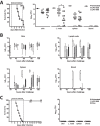Curative Treatment of Severe Gram-Negative Bacterial Infections by a New Class of Antibiotics Targeting LpxC
- PMID: 28743813
- PMCID: PMC5527309
- DOI: 10.1128/mBio.00674-17
Curative Treatment of Severe Gram-Negative Bacterial Infections by a New Class of Antibiotics Targeting LpxC
Abstract
The infectious diseases caused by multidrug-resistant bacteria pose serious threats to humankind. It has been suggested that an antibiotic targeting LpxC of the lipid A biosynthetic pathway in Gram-negative bacteria is a promising strategy for curing Gram-negative bacterial infections. However, experimental proof of this concept is lacking. Here, we describe our discovery and characterization of a biphenylacetylene-based inhibitor of LpxC, an essential enzyme in the biosynthesis of the lipid A component of the outer membrane of Gram-negative bacteria. The compound LPC-069 has no known adverse effects in mice and is effective in vitro against a broad panel of Gram-negative clinical isolates, including several multiresistant and extremely drug-resistant strains involved in nosocomial infections. Furthermore, LPC-069 is curative in a murine model of one of the most severe human diseases, bubonic plague, which is caused by the Gram-negative bacterium Yersinia pestis Our results demonstrate the safety and efficacy of LpxC inhibitors as a new class of antibiotic against fatal infections caused by extremely virulent pathogens. The present findings also highlight the potential of LpxC inhibitors for clinical development as therapeutics for infections caused by multidrug-resistant bacteria.IMPORTANCE The rapid spread of antimicrobial resistance among Gram-negative bacilli highlights the urgent need for new antibiotics. Here, we describe a new class of antibiotics lacking cross-resistance with conventional antibiotics. The compounds inhibit LpxC, a key enzyme in the lipid A biosynthetic pathway in Gram-negative bacteria, and are active in vitro against a broad panel of clinical isolates of Gram-negative bacilli involved in nosocomial and community infections. The present study also constitutes the first demonstration of the curative treatment of bubonic plague by a novel, broad-spectrum antibiotic targeting LpxC. Hence, the data highlight the therapeutic potential of LpxC inhibitors against a wide variety of Gram-negative bacterial infections, including the most severe ones caused by Y. pestis and by multidrug-resistant and extensively drug-resistant carbapenemase-producing strains.
Keywords: LpxC; animal models; antimicrobial drug; antimicrobial resistance; plague.
Copyright © 2017 Lemaître et al.
Figures




References
-
- Welch TJ, Fricke WF, McDermott PF, White DG, Rosso ML, Rasko DA, Mammel MK, Eppinger M, Rosovitz MJ, Wagner D, Rahalison L, Leclerc JE, Hinshaw JM, Lindler LE, Cebula TA, Carniel E, Ravel J. 2007. Multiple antimicrobial resistance in plague: an emerging public health risk. PLoS One 2:e309. doi:10.1371/journal.pone.0000309. - DOI - PMC - PubMed
MeSH terms
Substances
Grants and funding
LinkOut - more resources
Full Text Sources
Other Literature Sources
Medical
